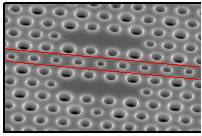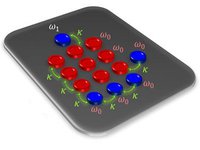Contact: Alejandro GIACOMOTTI
Coupled nanocavities are basic building blocks for the implementation of fundamental physical phenomena leading to spatial and temporal complexity such as the spontaneous symmetry breaking [1]. The way is now open for the exploration of coherent optical excitation (resonant driving), mesoscopic assemblies or small ensembles, and nanocavity networks. A number of interesting nonlinear dissipative phenomena can be explored with these platforms such as Josephson vortex, far-from- equilibrium thermodynamics and classical phase transitions, parity-time symmetry breaking and so forth, which constitute the first axis of the project.
Collaborators

Figure 1: Intercavity coupling control of photonic crystal cavities through barrier engineering (modification of the central row of holes).

Figure 2: Sketch of an active/passive cavity network (from M. Teimourpour et al, Sci. Reports. 6. 10.1038/srep33253)
Publications:
[1] P. Hamel, S. Haddadi, F. Raineri, P. Monnier, G. Beaudoin, I. Sagnes, A. Levenson, and A. M. Yacomotti, Spontaneous mirror-symmetry breaking in coupled photonic-crystal nanolasers, Nat Photon. 9, 311 (2015)